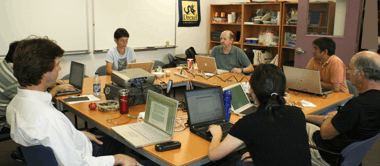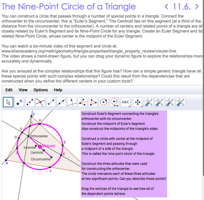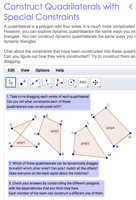Virtual Math Teams
Virtual Math Teams
Overview
Virtual Math Teams (VMT) was a research project directed by Gerry Stahl from 2003-2014 at the Math Forum at Drexel University in Philadelphia. A group of PhD students, Math Forum staff, interdisciplinary faculty, visiting researchers and international colleagues collaborated on the project.
The VMT Project was a paradigmatic example of computer-supported collaborative learning (CSCL). It developed an online service for math students to meet in small groups online to discuss challenging mathematical topics. It studied the usage of the technological environment designed for this service, using a method of chat interaction analysis that it refined. The project was guided by theories of collaborative learning, community knowledge building and group cognition, that it explored and developed. It is an example of postcognitivism theory and practice

Much of the VMT research takes place in weekly “data sessions”,[1] as pictured here.
A popular report on the beginnings of the VMT Project provides a good introduction: download it here.
The VMT Environment
The VMT online environment consists of a Lobby and many chat rooms for the collaborative discussion of math. In the Lobby, students can define their profiles and browse the profiles of other students. They can send messages to other people. Mainly, teachers and students can see what chat rooms are already defined.
Most chat rooms are associated with a math subject and an interesting problem or topic to explore and discuss. The chat rooms include a number of shared whiteboards for drawing and organizing ideas. There are also web browsers. Each chat room has an associated wiki page, where teams can share their findings publicly. The VMT wiki is open to the world for reading, but users must register in VMT to post information there. Users can also create a new chat room and invite people to it.
The VMT environment was originally based on ConcertChat, a collaboration infrastructure developed in Germany. At first it was extended for VMT by the original creators, then by Math Forum staff. It has subsequently been rewritten. ConcertChat and VMT are available as Open Source.
VMT Research
After a 2-year NSDL and a 6-year IERI grant from the US NSF ended, the VMT project collaborated with researchers at Carnegie-Mellon University through an NSF ALT grant to explore the use of software agents in the VMT environment; a list of publications related to the ALT grant is available here. An ONR CKI grant also supported continuing data analysis.
During this period, the VMT Project integrated the Open Source dynamic math system, GeoGebra, into the VMT system. This created the first public multi-user version of a dynamic mathematics environment. VMT is still the only truly multi-user version of the internationally popular GeoGebra system for dynamic geometry and other dynamic math domains.
In September 2011, a 5-year NSF DR K-12 grant extended major work on VMT. This grant supported the implementation of a more robust version of VMT-with-GeoGebra, with Math Forum technical support mainly by Tony Mantoan. Through weekly project meetings, the research team tried out different curricular approaches and developed a series of activities and tutorials for VMT-with-GeoGebra during 2011-2014—see Adventures in Dynamic Geometry.
The VMT system is fully instrumented to support data collection and micro-analysis for research and design feedback. The VMT Project has produced hundreds of publications (download list here), including nine doctoral dissertations and four books: Group Cognition (2006), Studying Virtual Math Teams (2009), Translating Euclid (2013) and Constructing Dynamic Triangles Together (2016).
The VMT online environment is available at the Math Forum at NCTM. Here is a view of it:

A VMT-mobile environment for tablets, iPads and all web browsers is also available. Here is a view of it:
VMT Publications
A GeoGebraBook with a VMT curriculum on constructing dependencies in dynamic geometry is available at: . This is an active book that lets one work on 50 team activities in GeoGebra. Unfortunately, since it runs outside of VMT in standard GeoGebra, it is not multi-user, it is not persistent, there is no chat and it is not instrumented for research or teacher analytics. Hopefully, GeoGebra will soon make its GeoGebraBooks multi-user. Here are some views of the VMT GeoGebraBook:



An extensive list of publications related to the VMT project is available at ; the most detailed presentations and reflections on all aspects of the project are: Studying Virtual Math Teams and Translating Euclid.
Group Cognition (MIT Press, 2006) provides the background to the VMT Project by showing the weaknesses of existing software and even innovative prototypes for supporting collaborative learning of mathematics. An initial analysis of proposal making interactions in VMT is included.
Studying Virtual Math Teams (Springer, 2009) tells the story of the VMT Project, in about 600 pages, in 28 chapters written by the research team members and collaborators from around the world. It includes reflections of issues of technology, pedagogy, theory and methodology.
Translating Euclid (Morgan & Claypool, 2013) is a multi-dimensional analysis of the attempt by the VMT Project to translate geometry education into a human-centered, computer-supported, collaborative-learning, dynamic-geometry pedagogy based on design research. Written from 2010-2013, the book discusses: the VMT vision, the history of geometry education, philosophical issues, the mathematics of dynamic geometry, collaborative learning, research methods, theory of referential resources, pedagogy, curriculum and design-based research.
Constructing Dynamic Triangles Together: The Development of Mathematical Group Cognition (Cambridge University Press, 2016). This monograph analyzes the work of a group of three students as they become introduced to dynamic geometry during eight hour-long online sessions using VMT with GeoGebra. The monograph documents the team's development of mathematical group cognition. Introductory chapters motivate the study and discuss its case-study method. Concluding chapters reflect on the group-cognitive development and its implications for re-design of the math curriculum.
Gerry Stahl's Assembled Texts is available at his eLibrary. It contains collected volumes of hundreds of essays and other texts related to the VMT Project. They can be downloaded for free in various formats.
References
- ↑ Jordan, B. & Henderson, A. (1995). Interaction analysis: Foundations and practice. Journal of the Learning Sciences. 4(1), 39-103. Web http://lrs.ed.uiuc.edu/students/c-merkel/document4.HTM